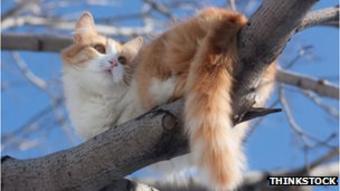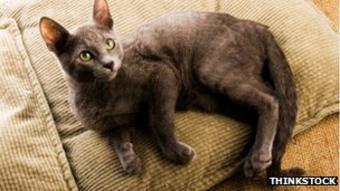-
IP addresses are NOT logged in this forum so there's no point asking. Please note that this forum is full of homophobes, racists, lunatics, schizophrenics & absolute nut jobs with a smattering of geniuses, Chinese chauvinists, Moderate Muslims and last but not least a couple of "know-it-alls" constantly sprouting their dubious wisdom. If you believe that content generated by unsavory characters might cause you offense PLEASE LEAVE NOW! Sammyboy Admin and Staff are not responsible for your hurt feelings should you choose to read any of the content here. The OTHER forum is HERE so please stop asking.
You are using an out of date browser. It may not display this or other websites correctly.
You should upgrade or use an alternative browser.
You should upgrade or use an alternative browser.
Man killed cat by hurling it down 14 floors,guilty of animal cruelty
- Thread starter KuanTi01
- Start date
Fucking cheebyekia deserve to be flung down from 40th storey ... I hate animal abusers!
Me too! Why take it out on small defenceless creatures? I always thought cats are gentle pets although they meow and scratch annoyingly sometimes.
After 3 dogs whom have spent their wonderful life with me to date and now in heaven... I am thinking of getting a Munchkin cat to accompany me...

Redundant. you got a china pussy riao
Cat must be a retard as most cats survive falls from high up.
Cat must be a retard as most cats survive falls from high up.
It's 14 floors up!

go and adopt one from cat shelter lahAfter 3 dogs whom have spent their wonderful life with me to date and now in heaven... I am thinking of getting a Munchkin cat to accompany me...

The Straits Times in the Home Section Page B5 has reported that a man killed a cat by hurling it down 14 floors. Of course he was found guilty despite being mentally ill.
Guess his race?
It's 14 floors up!
Who, What, Why: How do cats survive falls from great heights?
- 25 March 2012
- Share this with Facebook
- Share this with Messenger
- Share this with Twitter
- Share this with Email
- Share

A cat in the US city of Boston survived a fall from a 19-storey window and only bruised her chest. How do cats survive falls from such great heights?
The cat's owner Brittney Kirk, a nurse, left the window open a crack on Wednesday morning to give Sugar some air. Sugar got out and either fell or leapt off the ledge and hit a patch of grass and mulch.
An animal rescue service found her and traced her back to Ms Kirk through a microchip embedded in her skin.
"She's a tough little kitty," Ms Kirk told the Boston Globe newspaper.
Cats' remarkable ability to survive falls from great heights is a simple and predictable matter of physics, evolutionary biology, and physiology, veterinarians and biologists say.
ADVERTISEMENT
"This recent story isn't much of a surprise," says Jake Socha, a biomechanist at Virginia Tech university.
"We do know that animals exhibit this behaviour, and there have been lots of records of these cats surviving."
The answer
- Cats have relatively large surface areas in proportion to their weight, so fall at a slower rate over a great height than larger mammals
- Their bodies have evolved to allow them to survive falls from trees, their natural homes
- Given the time, they twist to land on their feet
- Their legs are long, muscular and extend under the body rather than straight down, allowing them to absorb the shock
- But many cats who fall from heights are nevertheless severely injured and some die
With scientists unwilling to toss cats off buildings for experimental observation, science has been unable systematically to study the rate at which they live after crashing to the ground.
In a 1987 study of 132 cats brought to a New York City emergency veterinary clinic after falls from high-rise buildings, 90% of treated cats survived and only 37% needed emergency treatment to keep them alive. One that fell 32 stories onto concrete suffered only a chipped tooth and a collapsed lung and was released after 48 hours.
From the moment they're in the air to the instant after they hit the ground, cats' bodies are built to survive high falls, scientists say.
They have a relatively large surface area in proportion to their weight, thus reducing the force at which they hit the pavement.
Cats reach terminal velocity, the speed at which the downward tug of gravity is matched by the upward push of wind resistance, at a slow speed compared to large animals like humans and horses.
For instance, an average-sized cat with its limbs extended achieves a terminal velocity of about 60mph (97km/h), while an average-sized man reaches a terminal velocity of about 120mph (193km/h), according to the 1987 study by veterinarians Wayne Whitney and Cheryl Mehlhaff.
This cat was lucky. But many, if not most, would have severe lung damage, would have a broken leg or two or three or four, maybe have damage to the tail, and maybe more likely than any of that a broken jaw or dental damageSteve Dale, Cat behaviour specialist
Cats are essentially arboreal animals: when they're not living in homes or in urban alleys, they tend to live in trees.Sooner or later, they're going to fall, biologists say. Cats, monkeys, reptiles and other creatures will jump for prey and miss, a tree limb will break, or the wind will knock them over, so evolution has rendered them supremely capable of surviving falls.
"Being able to survive falls is a critical thing for animals that live in trees, and cats are one of them," says Dr Socha. "The domestic cat still contains whatever suite of adaptations they have that have enable cats to be good up in trees."
Through natural selection, cats have developed a keen instinct for sensing which way is down, analogous to the mechanism humans use for balance, biologists say.
Then - if given enough time - they are able to twist their bodies like a gymnast, astronaut or skydiver and spin their tails in order to position their feet under their bodies and land on them.
WHO, WHAT, WHY?
A part of BBC News Magazine, Who, What, Why? aims to answer questions behind the headlines
"Everything that lives in trees has what we call an aerial righting reflex," says Robert Dudley, a biologist at the animal flight laboratory at the University of California - Berkeley.
Cats can also spread their legs out to create a sort of parachute effect, says Andrew Biewener, a professor of organismal and evolutionary biology at Harvard University, although it is unclear how much this slows the rate of descent.
"They splay out their legs, which is going to expand their surface area of the body, and that increases the drag resistance," he says.
When they do land, cats' muscular legs - made for climbing trees - act as shock absorbers.

"Cats have long, compliant legs," says Jim Usherwood of the structure and motion lab at the Royal Veterinary College. "They've got decent muscles. In that they're able to jump quite well, the same muscles divert energy into decelerating rather than breaking bones."
The springy legs increase the distance over which the force of the collision with the ground dissipates, says Dr Biewener.
"The impact forces are much higher in stiff collisions," he says. "If they can increase the collision time over a longer period, that reduces the impact force."
And a cat's legs are angled under the body rather than extended downward, like human or horse legs.
"You're not transmitting the forces really directly," says Dr Socha.
"If the cat were to land with its legs directly under him in a column and hold him stiff, those bones would all break. But they go off to the side and the joints then bend, and you're now taking that energy and putting it into the joints and you're getting less of a force at the bone itself."
However, house cats in urban or suburban areas tend to be overweight and in less than peak physical condition, warns Steve Dale, a cat behaviour consultant who is on the board of the Winn Feline Foundation, which supports cat health research.
That detracts from their ability to right themselves in midair, he says.
"This cat was lucky," he says. "But many, if not most, would have severe lung damage, would have a broken leg or two or three or four, maybe have damage to the tail, and maybe more likely than any of that a broken jaw or dental damage.
"The lessons learned: screens, please, on the windows."
Face of a murderer.
After 3 dogs whom have spent their wonderful life with me to date and now in heaven... I am thinking of getting a Munchkin cat to accompany me...

Sadly, my 13 yo, doggo also departed me this year. Even though i love cats (been feeding my community cats for past few years), my heart still lean towards getting another dog. If im ever getting a cat, ragdoll and munchkin would be the two breeds i would love to take care of.
The laws with regards towards animal abuses in SG is really pathetic.
Who, What, Why: How do cats survive falls from great heights?
- 25 March 2012
- Share this with Facebook
- Share this with Messenger
- Share this with Twitter
- Share this with Email
- Share
Image captionComfy? Cats are evolutionarily adapted to live in trees - luxury living with humans is a recent development
A cat in the US city of Boston survived a fall from a 19-storey window and only bruised her chest. How do cats survive falls from such great heights?
The cat's owner Brittney Kirk, a nurse, left the window open a crack on Wednesday morning to give Sugar some air. Sugar got out and either fell or leapt off the ledge and hit a patch of grass and mulch.
An animal rescue service found her and traced her back to Ms Kirk through a microchip embedded in her skin.
"She's a tough little kitty," Ms Kirk told the Boston Globe newspaper.
Cats' remarkable ability to survive falls from great heights is a simple and predictable matter of physics, evolutionary biology, and physiology, veterinarians and biologists say.
ADVERTISEMENT
"This recent story isn't much of a surprise," says Jake Socha, a biomechanist at Virginia Tech university.
"We do know that animals exhibit this behaviour, and there have been lots of records of these cats surviving."
The answer
Lucky cat survives 19-storey fall
- Cats have relatively large surface areas in proportion to their weight, so fall at a slower rate over a great height than larger mammals
- Their bodies have evolved to allow them to survive falls from trees, their natural homes
- Given the time, they twist to land on their feet
- Their legs are long, muscular and extend under the body rather than straight down, allowing them to absorb the shock
- But many cats who fall from heights are nevertheless severely injured and some die
With scientists unwilling to toss cats off buildings for experimental observation, science has been unable systematically to study the rate at which they live after crashing to the ground.
In a 1987 study of 132 cats brought to a New York City emergency veterinary clinic after falls from high-rise buildings, 90% of treated cats survived and only 37% needed emergency treatment to keep them alive. One that fell 32 stories onto concrete suffered only a chipped tooth and a collapsed lung and was released after 48 hours.
From the moment they're in the air to the instant after they hit the ground, cats' bodies are built to survive high falls, scientists say.
They have a relatively large surface area in proportion to their weight, thus reducing the force at which they hit the pavement.
Cats reach terminal velocity, the speed at which the downward tug of gravity is matched by the upward push of wind resistance, at a slow speed compared to large animals like humans and horses.
For instance, an average-sized cat with its limbs extended achieves a terminal velocity of about 60mph (97km/h), while an average-sized man reaches a terminal velocity of about 120mph (193km/h), according to the 1987 study by veterinarians Wayne Whitney and Cheryl Mehlhaff.
This cat was lucky. But many, if not most, would have severe lung damage, would have a broken leg or two or three or four, maybe have damage to the tail, and maybe more likely than any of that a broken jaw or dental damageSteve Dale, Cat behaviour specialistCats are essentially arboreal animals: when they're not living in homes or in urban alleys, they tend to live in trees.
Sooner or later, they're going to fall, biologists say. Cats, monkeys, reptiles and other creatures will jump for prey and miss, a tree limb will break, or the wind will knock them over, so evolution has rendered them supremely capable of surviving falls.
"Being able to survive falls is a critical thing for animals that live in trees, and cats are one of them," says Dr Socha. "The domestic cat still contains whatever suite of adaptations they have that have enable cats to be good up in trees."
Through natural selection, cats have developed a keen instinct for sensing which way is down, analogous to the mechanism humans use for balance, biologists say.
Then - if given enough time - they are able to twist their bodies like a gymnast, astronaut or skydiver and spin their tails in order to position their feet under their bodies and land on them.
WHO, WHAT, WHY?
A part of BBC News Magazine, Who, What, Why? aims to answer questions behind the headlines
"Everything that lives in trees has what we call an aerial righting reflex," says Robert Dudley, a biologist at the animal flight laboratory at the University of California - Berkeley.
Cats can also spread their legs out to create a sort of parachute effect, says Andrew Biewener, a professor of organismal and evolutionary biology at Harvard University, although it is unclear how much this slows the rate of descent.
"They splay out their legs, which is going to expand their surface area of the body, and that increases the drag resistance," he says.
When they do land, cats' muscular legs - made for climbing trees - act as shock absorbers.
Image captionCats' legs are springy and muscular, letting them absorb the shock of impact
"Cats have long, compliant legs," says Jim Usherwood of the structure and motion lab at the Royal Veterinary College. "They've got decent muscles. In that they're able to jump quite well, the same muscles divert energy into decelerating rather than breaking bones."
The springy legs increase the distance over which the force of the collision with the ground dissipates, says Dr Biewener.
"The impact forces are much higher in stiff collisions," he says. "If they can increase the collision time over a longer period, that reduces the impact force."
And a cat's legs are angled under the body rather than extended downward, like human or horse legs.
"You're not transmitting the forces really directly," says Dr Socha.
"If the cat were to land with its legs directly under him in a column and hold him stiff, those bones would all break. But they go off to the side and the joints then bend, and you're now taking that energy and putting it into the joints and you're getting less of a force at the bone itself."
However, house cats in urban or suburban areas tend to be overweight and in less than peak physical condition, warns Steve Dale, a cat behaviour consultant who is on the board of the Winn Feline Foundation, which supports cat health research.
That detracts from their ability to right themselves in midair, he says.
"This cat was lucky," he says. "But many, if not most, would have severe lung damage, would have a broken leg or two or three or four, maybe have damage to the tail, and maybe more likely than any of that a broken jaw or dental damage.
"The lessons learned: screens, please, on the windows."
But these cats fell down not because they were thrown down by a mad guy! Anyway, most of these cats will die anyway if not outright, then in due course because of their severe injuries.
Looks good...I will get one tooAfter 3 dogs whom have spent their wonderful life with me to date and now in heaven... I am thinking of getting a Munchkin cat to accompany me...

Just now had an overseas telephone conversation with my ATB Shanghai girlfriend ... Told her about buying a Munchkin cat..She said exactly the same as you... Lolgo and adopt one from cat shelter lah

Just now had an overseas telephone conversation with my ATB Shanghai girlfriend ... Told her about buying a Munchkin cat..She said exactly the same as you... Lol
Tsk tsk.... typical old fart w China gf.
What to do.. beggars can't be choosersTsk tsk.... typical old fart w China gf.

Face of a murderer.
Face of a seow lang lah
After 3 dogs whom have spent their wonderful life with me to date and now in heaven... I am thinking of getting a Munchkin cat to accompany me...

Looks cute. But if i were u i dont think i have the heart to keep any animals. I love animals too. Just like humans...we believe they have souls too. So when their time is up is so painful letting them go.....:(
Similar threads
- Replies
- 0
- Views
- 218
- Replies
- 2
- Views
- 483
- Replies
- 5
- Views
- 1K
- Replies
- 5
- Views
- 420
